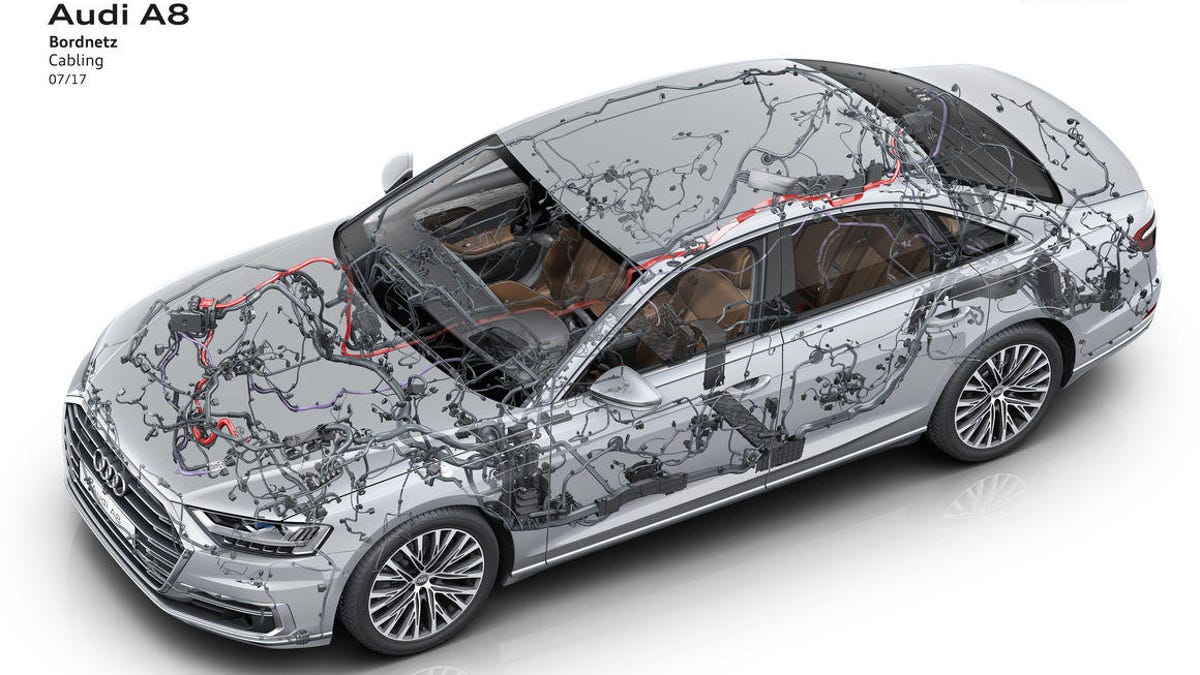Audi's new A8 offers proper hands-off autonomy in traffic
Flagship sedan enables hands-off driving for your bumper-to-bumper commute, but whether it's legal in the US remains to be seen.

The 2019 Audi A8 is packed to its Alcantara headliner with leading-edge tech that brings us closer to self-driving cars than ever before. According to the German automaker, the A8 will be the first production car in the world to include lidar technology, which Audi says is integral to offering full-fledged Level 3 autonomy. That is, the ability for the car to completely drive itself in limited circumstances.
Of course, that optional functionality comes within a specific set of operating parameters. Dubbed AI Traffic Jam Assist, the system works at speeds of up to 37 miles an hour on roads with a physical barrier between the car and oncoming traffic. Practically speaking, this means usage will be limited to freeways, as when commuting during rush-hour traffic.
We've seen semi-autonomous tech like this before in other cars, right? Not exactly. Essentially, all of today's competing systems are Level 2, placing a strict — and generally short — time limit on how long you can go hands-off, typically triggering audible chimes and instrument cluster warnings urging the driver to retake control. If the driver fails to respond, such systems disable themselves, effective forcing the driver into compliance.
Audi's new A8 takes us further down the road to self-driving cars than ever before.
As I learned during a roundtable media event at the A8's introduction in Barcelona on Tuesday, this BMW 7 Series and Mercedes-Benz S-Class rival doesn't do that — at least under certain conditions. If a traffic jam has you rubber-banding along the freeway at low speeds, the 2019 A8 will let you stay hands-off the entire time, so you're free to check on your kids in the back seat, play a game on your phone, or even watch TV on the center display.
Of course, if the road ahead clears and traffic accelerates beyond Traffic Jam Assist's 37-mph threshold, the system will audibly and visually alert the driver to retake control, giving him or her a 10-second window to get with the program. Should they fail to do so, the car will begin slowing down, eventually coming to a full stop within its lane, engaging its four-way flashers to warn other motorists, and its vehicle-to-infrastructure (V2X) connected-car tech will report the car is stopped. Finally, the A8's telematics system will also signal Audi's Online Roadside Assistance center to call the vehicle to see if anything is wrong.
How confident is Audi in its Traffic Jam Assist hardware? According to Alex Vukotich, Audi's head of automated driving, "it's meant to be a Level 3 System, so the driver can really relax, can do something else. He doesn't have to be in charge of observing what the system is doing, the system will do everything."
Traffic Jam Assist fuses lidar, camera, short- and long-range radar and ultrasonic sensor data.
Dr. Peter Mertens, Audi's head of technical development goes a step further, noting that when Traffic Jam Assist is active, "There is no shared responsibility. So when the car drives autonomously, it is responsible." I asked Martens and Vukotich if that means Audi assumes full legal culpability in that operating condition, and they both nodded and said "Yes."
That last bit feels like a significant milestone in the industry's march to self driving. Some time ago, Volvo stated that it would assume legal responsibility for when its cars are operating fully autonomously, but it hasn't put such hardware in full production yet — it's presently still evaluating its tech in Sweden using its Drive Me test fleet.
However, just because the new Audi A8 is built with semi-autonomous capabilities doesn't necessarily mean you'll be able to order it when the car goes on sale in North America next year. At the moment, when it comes to developing self-driving tech, including things like AI Traffic Jam Assist and the A8's out-of-car remote parking assistant, automakers are outpacing the legal framework their vehicles will be forced to operate within.
Governments around the globe — including those of the US and Canada — are hammering out legislation that will determine what is legal for automakers to offer. According to an Audi release, "The introduction of the Audi AI traffic jam pilot means the statutory framework will need to be clarified in each individual market, along with the country-specific definition of the application and testing of the system…Audi will therefore be adopting a step-by-step approach to the introduction of the traffic jam pilot in production models." Of course, It's entirely possible that such bureaucratic issues will be resolved in time for the A8 to launch with this tech in America, but even then, I wouldn't bet on Uncle Sam simultaneously allowing Audi owners to watch "Game of Thrones" in the driver's seat, even if the A8 is capable of it.
Audi's headlong push into Level 3 autonomy comes as many in the industry are fretting over "the handoff" — that moment when semi-autonomous systems turn driving back over to the human in the front seat. Some automakers and technology companies like Alphabet's Waymo have resolved to simply skip L3 altogether and move straight to L4 and beyond, where essentially all facets of driving are controlled by the car at all times and all speeds.
Either way, as evidenced by this new Audi A8 and Cadillac's nearly here Super Cruise system, it's quite clear that the auto industry is comfortable pushing the accelerator on self-driving tech. However, it's not yet clear whether the world's governments are ready to do the same. Perhaps just as importantly, it likewise remains to be seen how eager buyers will be to experience, trust and pay for this tech, too.

